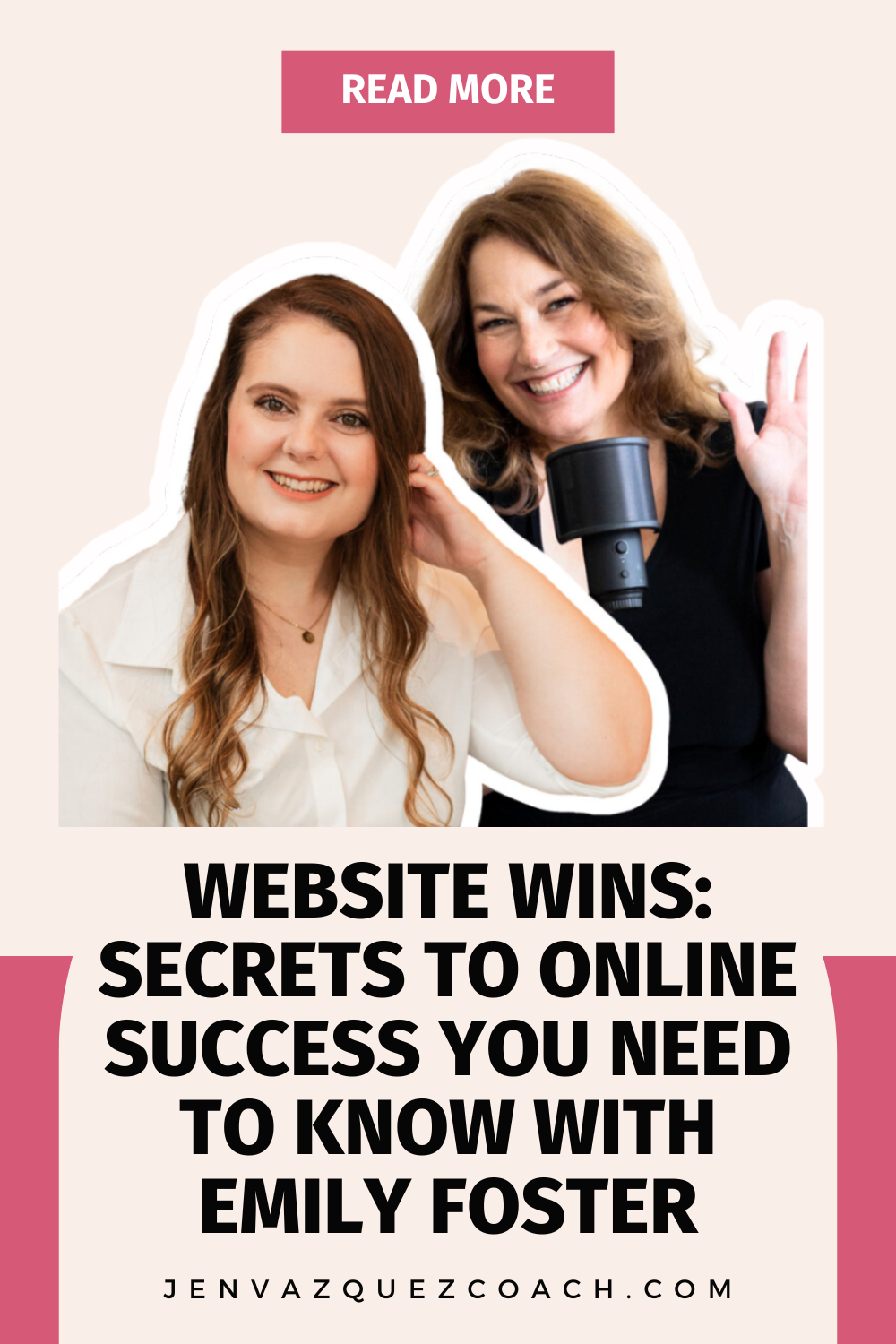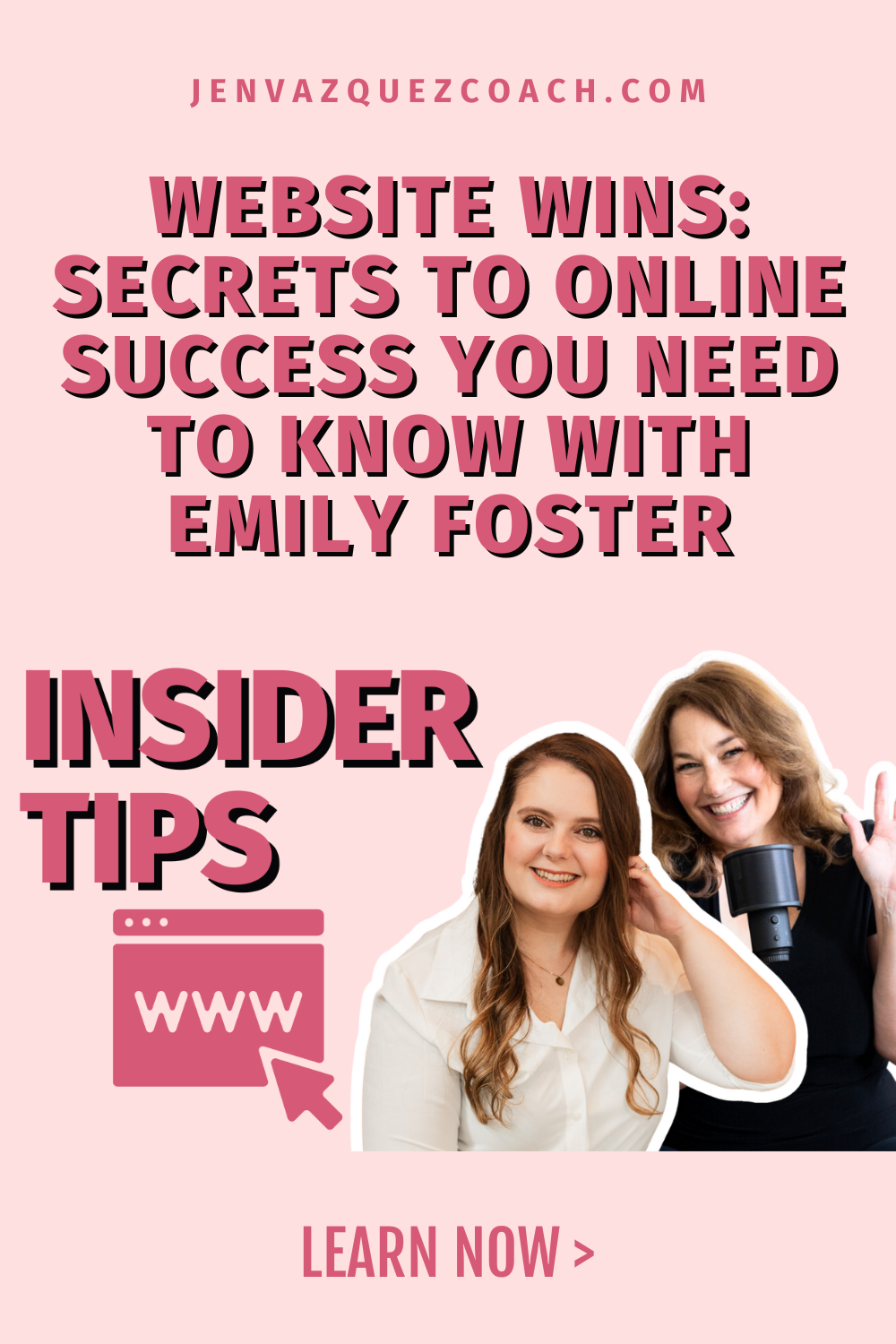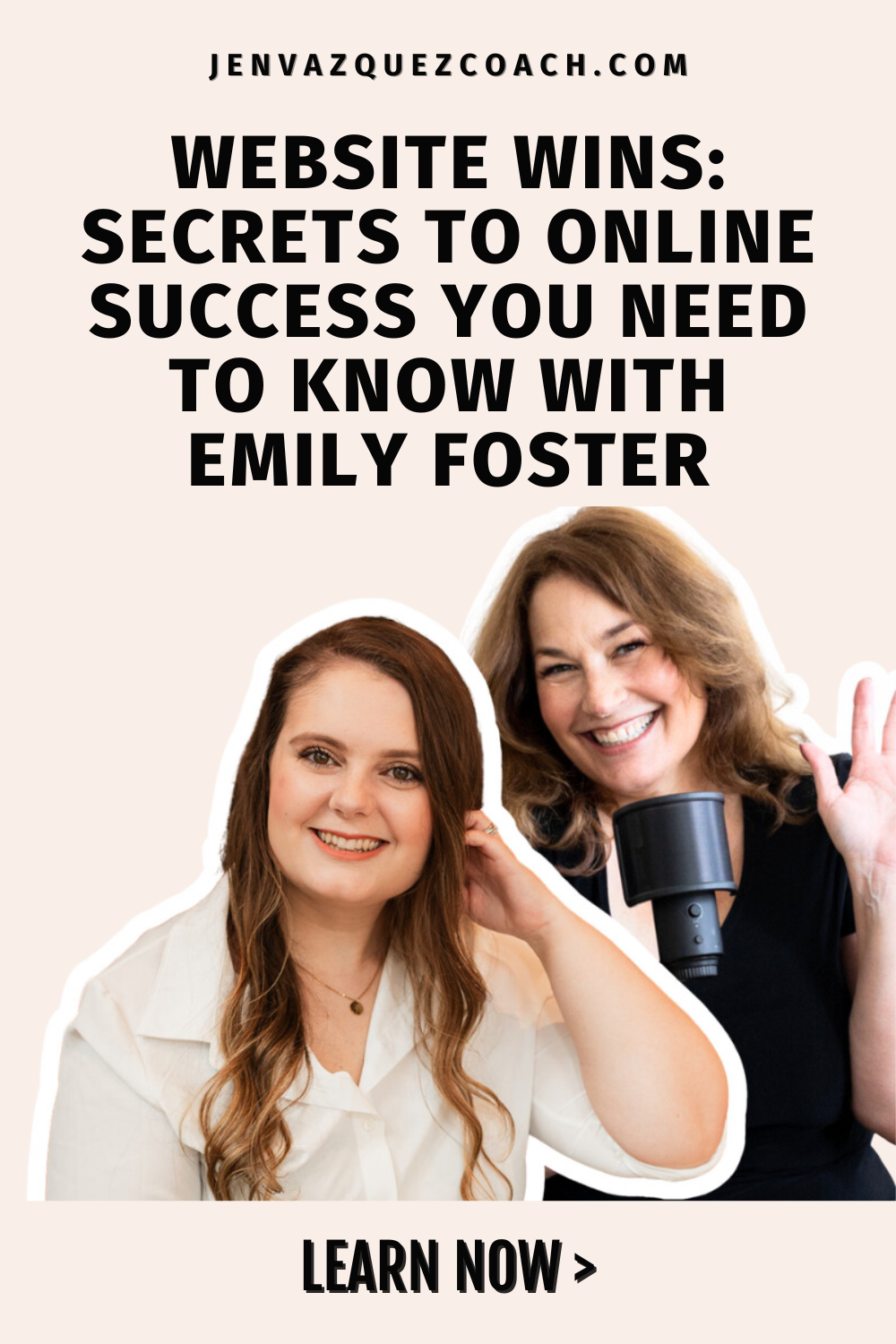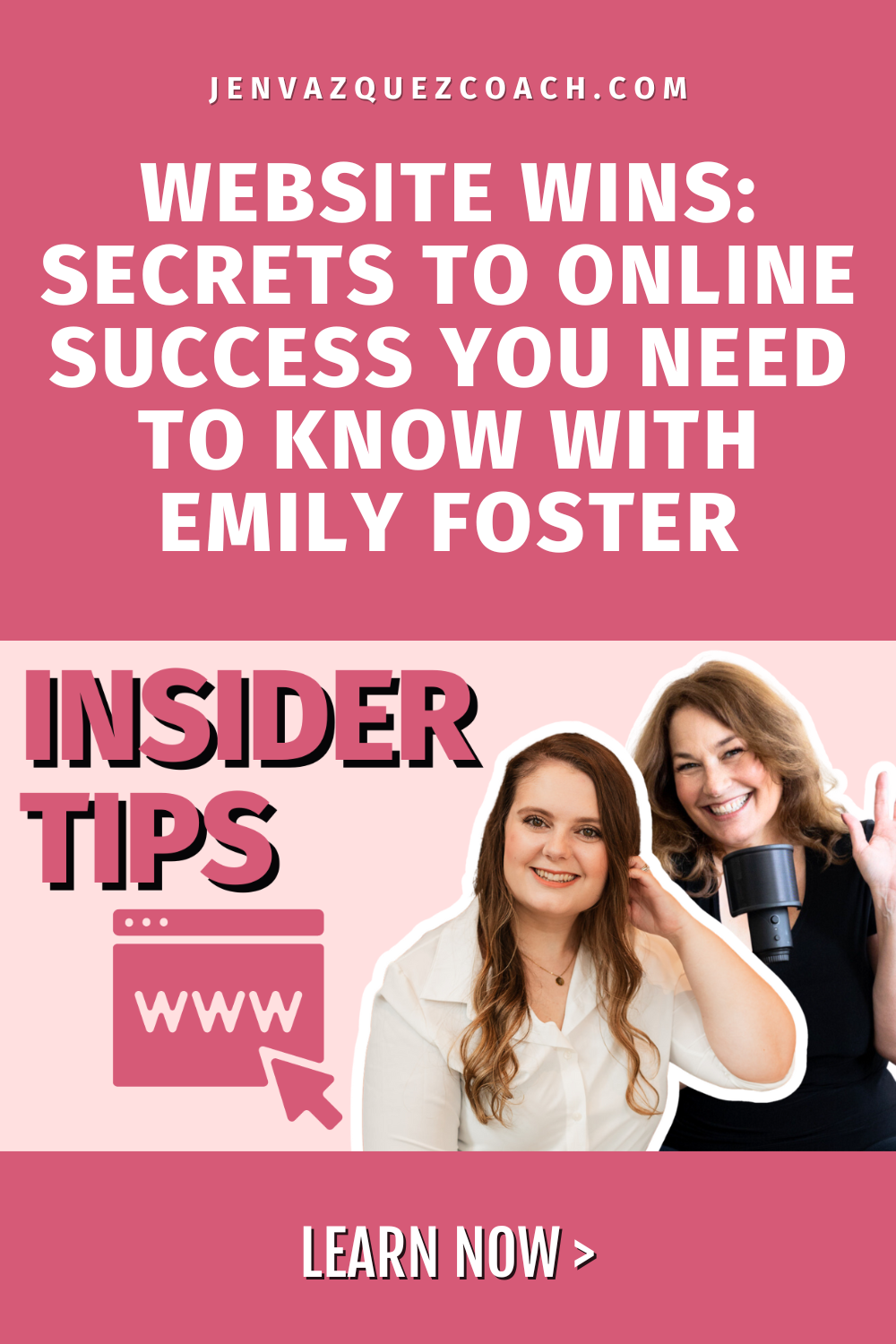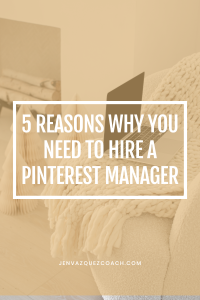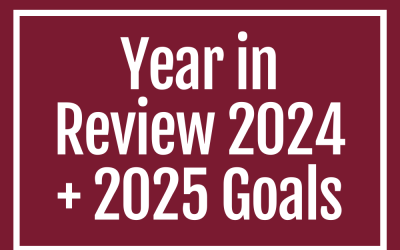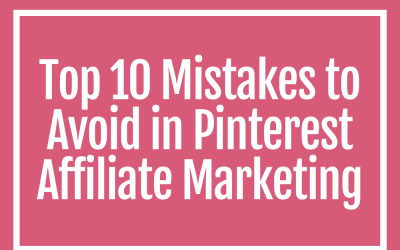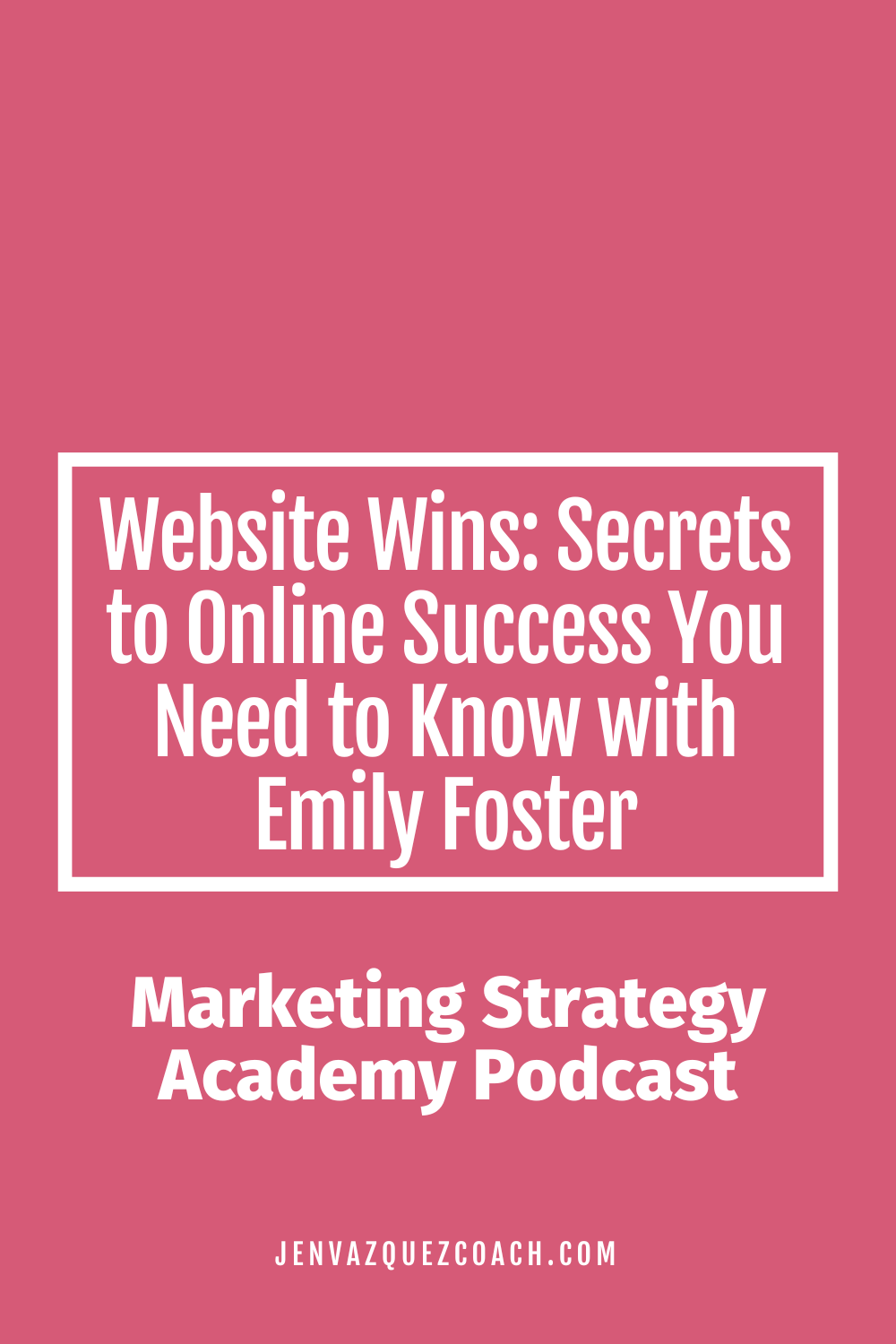
Website Wins: Secrets to Online Success You Need to Know with Emily Foster
Ever wondered what makes a website not just good, but great? What secrets are top brands using to pull in traffic and convert visitors into loyal fans? Transcript below!
Gifts: Elevated Website Checklist
Where to Find NAME:
Listen to the Podcast or Watch on YouTube
Transcript:
Website Wins: Secrets to Online Success You Need to Know With Emily Foster
Jen Vazquez: [00:00:00] Have you ever wondered what makes a website not just good, but great? What secrets are top brands using to pull in traffic and convert visitors into loyal fans? Stick around because my next guest is sharing all about it.
Welcome back. And if you’re new here, I’m Jen Vazquez and I help hyper busy female service providers use Pinterest to book more clients and increase their income and impact.
And on this podcast, I host expert interviews. all about marketing so that you can always get better. If marketing is something that you want to learn more about for your business, please subscribe to our podcast or our YouTube channel because that’s how we grow. And today I am so excited to be chatting with Emily Foster of Emily Foster Creative.
Emily is the owner of Emily Foster Creative, a brand and website design studio based in Portland, Oregon, and working with creatives everywhere. She specializes in helping wedding [00:01:00] vendors and photographers stand out with personalized tailored branding and website design. She brings eight plus years of experience to helping business owners get clear on their brand strategy and then transforming that into a brand that connects with their ideal clients.
She lives in Portland, Oregon with her husband and her two cats. And , when she’s not working, you can find her reading, exploring local spots or planning to travel somewhere new. Welcome Emily.
Emily Foster: Hey, thank you so much for having me.
Jen Vazquez: , let’s dive in because I know everyone’s going to be eager to hear from you.
, we always start with this question because I love to find out, , all the different things that got you to where you are today. So tell us a little bit about how you got to where you are today in your business.
Emily Foster: , so I basically went to college for business originally. I went to university of Oregon where Nike was started. So I kind of went with the idea that I wanted to major in business, maybe like sports [00:02:00] business. They have a specific sports business major there and then work for Nike someday.
And then I also, was double majoring in journalism because I was always really interested in that. And basically, we had like a journalism and a business school. So I was learning a lot about communication and like art and then also business and kind of took that path. to end up focusing on advertising and specifically design.
So graduated kind of with a different kind of design degree. It wasn’t necessarily traditional art school design, but more like a strategic business oriented design degree. So that was really interesting to kind of come at it from that perspective. And then I worked in several agencies and, , I feel like they all had in common that they had kind of a startup vibe and just like that.
Hustle culture. So I feel like I had some qualities of an entrepreneur already where I was just doing a lot of different tasks in my roles and, , wasn’t necessarily always doing what I went to school for. So at the time I think, , I probably didn’t appreciate that as much. I think I was [00:03:00] kind of like, okay, well this isn’t exactly what I want to do.
But now as an entrepreneur, I think that’s super valuable. And then I also was always kind of dabbling a little bit in photography and even was interested in becoming like a wedding planner someday, , and doing event planning. My first actual, like, design project was in high school and it was planning a fundraising event and, , designing t shirts for it.
Like, I used Microsoft Publisher. It was so embarrassing. And then, , designing all the presentations and everything for that as well. So, , kind of always had that background. And then it wasn’t until 2021, , almost a full year into COVID. I was one of the last people to be laid off of my team at an events marketing agency.
they just basically had a lot of in person event clients and that’s kind of what happened, unfortunately, and really. Yeah, I kind of always sensed that there was this entrepreneur path for me. Like I wasn’t loving the nine to five structure and like being limited to taking just two weeks off a [00:04:00] year, kind of things like that.
But of course, I think a lot of us are terrified to make the jump. So. I kind of feel like it was like me being pushed into taking that path. And so when I was laid off, I, , kind of job hunted a little bit freelanced. And then ultimately that year ended up forming my business and deciding to niche with working with wedding pros and photographers.
I was planning my wedding at the time too. So it felt very strategic. Yeah, exactly. Like I was able to, , kind of say what worked and didn’t work about brands and websites that we were coming across, , both from the client perspective and then also from an actual web designer perspective too.
Jen Vazquez: very, very cool. So I have, was a wedding photographer since 2009. And recently at the end of last year, I’m switching into more of the, , brand photography because with my Pinterest marketing business and brand photography, it just all like fit together. , , I get you. So I, I got married before I was a [00:05:00] wedding photographer.
Billion years ago, , I have four adult kids and two of them got married. So from a mom perspective and a money perspective, looking at all the websites, they were looking at Instagram and saying, Oh, I went this person, I went this person. And then I’d look at their website and I was like, Ooh, you know?
So yeah, it’s a big problem obviously for wedding pros because we’re like one person wearing 18 million hats and oftentimes website is like the last thing to get done, like we’re just doing it ourselves, , but it is so effective to driving more leads. I, I’m very excited about this conversation.
Emily Foster: And it’s crazy too when you think about it, like on that topic, I think the wedding industry is the only one I’ve come across so far where you’re kind of expected to spend so much money, but then the websites and brands are so low quality. Like when you think about it, , some lawyers and accountants and dentists and things like that, their websites aren’t the best, but [00:06:00] usually they’re like.
Still somewhat professional and updated and maybe not the most artistic, but there are really like a lot of wedding venues in particular where ones that we came across where we’re like, okay, all of these minimum are going to be at least 3, 000. And these are from like 2000,
that weird point where like, we’re all small business owners, but it’s a luxury industry, like. It’s this weird point where you really have to care about your website, but you are charging premium prices.
Jen Vazquez: So let’s go ahead and dive in because I know everyone’s ears are perked at this point. What are the top three must have elements that you think every successful should include and why?
Emily Foster: Yeah. I think that branding is first. , so a very consistent professional brand, whatever that looks like for you. So I really believe that you could be a high end luxury vendor and have like the light and airy editorial look, or you could also be like colorful and bold or dark and moody. But Your branding needs to be high end and [00:07:00] it needs to be consistent.
And it’s just not something that I tend to see a lot from people who DIY their brands. So a professional high end brand, , which people forget about because they just want to jump to having a successful website and having it look good. But the brand is what makes it look good. Really. And then I would say clear messaging that really aligns with your clients.
So that comes from your brand strategy, which also motivates like the aesthetic of it. But this is all about your website copywriting, which isn’t the legal text on your website. That’s actually the text on your website, like the writing and the headlines and everything that is very sales driven, but also brand voice oriented.
so getting really clear on that and not using your website as. , an online resume or brochure, but actually using it as more like a digital billboard with more wording, , where you can really clearly express what it is that you provide and the value that you give to your clients. And then the third one, I feel like this is a controversial opinion.
To some [00:08:00] people, but to some web designers it is, where, like, I just think that you have to have SEO, working for you. And know that seems
Jen Vazquez: be controversial. That like top mistakes that people make.
Emily Foster: Yeah, but there are a lot of photographers, especially and other wedding pros out there who are like, well, my work speaks for itself.
I have my Instagram. I don’t really need SEO, but I just feel like you’re cutting yourself off from a huge source of traffic if you aren’t paying attention to that. And otherwise, like, why not just have, like, A Canva file or something that you’re linking from your Instagram bio. So SEO, which kind of relates to content, having really valuable content on your website that connects with people, not just like spammy backlinks and things like that that are driving traffic to your website.
Jen Vazquez: Yeah, a couple of things that pop up in my head on that is, , yes, our photo, you know, as a photographer, like I get that my photography speaks for itself. , but. What most photographers don’t think about because all they’re focusing [00:09:00] on is referrals, the SEO brings a new eyeballs on your content. This is people that you would never be able to touch on Instagram at all.
It’s search marketing. It’s within Google, and it works extraordinarily well, and it is great. It is non-negotiable, , if you wanna have a good, strong business with leads coming in. The other thing I wanna point out that is so important, and you touched on it a little bit, but I kind of wanna go deeper into it, is oftentimes, , and I’ll speak for myself as a photographer, I started out by saying, Hey, I’ve been photographing since 2009.
I, I, I, I, I, I, I, all the website and nobody about me.
Emily Foster: to you.
Jen Vazquez: one cares. All they care about is I want a photographer that I can like vibe with because I’ll be with that photographer more than my future husband on that day. And You need to talk directly to them. So like I completely changed over, obviously years ago now, but I [00:10:00] completely changed over and said, if you’re a fun, adventurous, playful couple, like that just says my ideal client.
And those three words, I’m talking to them and people contacted me from other states, even because they’re like, you just like spoke to me
Emily Foster: Yeah,
Jen Vazquez: people don’t realize how valuable that is.
Emily Foster: exactly. I feel like I love that you talked on, , reaching out from other states too, because that’s one of the reasons for SEO that I think it’s so important. A lot of it for creative businesses is going to be local SEO, like trying to rank for your or state. But what I see often is photographers, businesses just plummet when they move.
States. And, , because you have an Instagram following, but honestly, a lot of the time your Instagram following is referrals, like past clients and their networks. So if you move across the country, you’re kind of losing your referrals for a little while until you building up that network. And then, yeah, Instagram, we know, we don’t own that and it’s not evergreen content either.
So that’s why I love when you talk about [00:11:00] Pinterest, that’s another form of
Jen Vazquez: Yes.
Emily Foster: Right.
Jen Vazquez: Well, and let’s be honest, I mean, if we’re lucky, 3 percent of the people that have chosen to follow us even see our content. So like, it’s not robust. Period. The end.
Emily Foster: . Yeah. It’s limitless opportunity with SEO, so that’s kind of, I guess, probably its own podcast recording as well, but yeah, definitely connecting with your clients. , I was saying like, change I to you by making it more them and the problems that you’re solving and, kind of putting it harshly.
Most photographers have a very similar background, like not to
Jen Vazquez: grabbed a camera one day and decided to photographer. It’s just, cares?
Emily Foster: definitely, you’re totally unique and you have a unique perspective, obviously that you can share, but it’s not like we’re all brain surgeons saving the world. Like we don’t have like this, like super special story that people need to hear about all over your website. You should definitely have it somewhere on your website, but
Jen Vazquez: your About [00:12:00] Me, maybe, but even the About Me section should be more about them. And then you can touch on yourself at the bottom.
Emily Foster: right. Yeah. It needs to be really about what you’re selling and the value you provide with
Jen Vazquez: Yes. So, , and this is the other thing that I, I get triggered about because I feel like, there’s so many amazing photographers out there and they just don’t have this built into their website. How important is user experience in website design? And can you share some sort of simple changes maybe that would lead to some big improvement and engagement?
Emily Foster: Yes. fourth, , kind of answer to that question where you’re talking about top three. So lately I’ve been talking about like the top five pillars of your website and like first three that I said, and then also, , your user experience or website design and then brand strategy is kind of its own separate one. It’s like separate from
To all these things. Yeah. , user experience is huge and it’s kind of [00:13:00] crazy like how much people can miss the mark on this because it’s complicated. Like it’s legitimately like an entire master’s program that some people take is user experience for website design.
And then for me it was like a couple of classes in college basically, but, , thinking about what actions you want your, , visitors to take when they get to your website and making. sure that in general, you’re not making them click more than two times to get to something that is the end goal. So for most, , creative wedding businesses, it’s going to be contacting you or booking a call.
So. You really need to have some kind of contact button in your top navigation somewhere. , I always like to have a call to action or button in the top fold of your website, which is like that first section. , and that gets missed a ton for photographers, especially because we want to show your gorgeous, , galleries.
And there’s also certain website platforms that don’t let you kind of balance. like Squarespace, for example, right now, as of like early 2024, you can’t just like place a button on top of a beautiful [00:14:00] gallery. So there’s kind of customization without using code, I should say. You can do that if you customize
Jen Vazquez: Yes. It’s not drag and drop. Yes.
Emily Foster: right.
Yeah. So that kind of like, you kind of sacrifice some of the high end or unique look that you’re going for in order to follow these user experience rules in certain platforms. , . That would be something just making it really easy for them to contact you, , paying attention to your mobile experience because that gets forgotten so often.
And that’s thing about platforms, , when we’re talking about, like, Squarespace versus ShowIt or WordPress or Wix, so, optimizing that mobile view is difficult on some platforms, especially if you’re DIYing your website. Paying attention to that because probably the majority of your clients are visiting you through your mobile version of the website.
And then also making it super easy on the contact page for them to contact you. So not having a glitchy or really lengthy form. I feel like We tend to think that this is like some kind of application process. , [00:15:00] in reality, if you want to be competitive with other photographers in most sectors of industries, you need to have like a really short, easy to fill form because other people are making it simple for their clients.
So if you want to be able to get a lot of inquiries and book sales calls, like make it simple. , another little thing that I put, , on my lists for people usually is. to link your phone number or your email. So it’s just really easy for them to click it and then give you a call or shoot you an email.
That’s something that’s really often forgotten.
Jen Vazquez: Most people do not want to fill out a form. When they’re getting married, there’s so much work to do for getting married and they don’t want to be on 18 million email lists. So people try to , avoid that if possible. So I think that’s really smart to have a text or call or some, , , link to your email for sure.
Emily Foster: . Yeah, definitely. Like you don’t have to put your phone number on your website, but if you do just make it super easy for them to contact you. I’ve used the example a lot of when we were planning our own wedding and we were [00:16:00] kind of. In the middle of a venue tour day and trying to reach out to like planners and other vendors.
I just kind of closed out of websites where I couldn’t easily shoot them an email because I didn’t have the time, especially on mobile with some of these bad mobile sites. I didn’t have the time to fill out forms. And if I couldn’t easily click their email, if I had to copy and paste it and put it into my email client app, it just.
wasn’t going to work for me at that time because we were so busy that day. And that’s how little time you have is really like less than 20 minutes when someone’s in the car doing something else for their wedding or they’re on their break. So you have to think about like, how can we make it as easy as possible for them to get in touch right then.
Jen Vazquez: One other thing I’d love for you to touch on that wasn’t, , I wasn’t planning on asking this, but that totally piqued my curiosity. Cause I do hear this complaint for people planning weddings is to not very readily and clearly show where you are. . Sometimes people will land on your website from Pinterest or somewhere.
Right. And they’re just like [00:17:00] looking for that information. And they’re like, Oh, this person, I really like this person, but you can’t find anywhere on the website. If they’re in New York and I’m in California, like 90 percent of couples are not going to pay for travel. Some do. That’s great. But we, we kind of need to have some kind of area on there. Do you think?
Emily Foster: Yeah, definitely. And that’s essential for your SEO too. So, and if you can try to get more specific to like, if you’re living in a place like California or Texas, like it usually not is going to cut it, like to put just California or Texas, like try to put like Northern California, especially like if you aren’t willing to kind of cover that travel, like if you’re in LA and you don’t want to have to.
Pay for your own travel up to the Bay Area, or you’re not attracting like high enough clientele that can pay for that, then don’t put that,
Jen Vazquez: Yeah. I, I use Bay Area. I use San Jose, which is the city I live in. And I’ll sometimes use Northern California, but it [00:18:00] is sort of really clear when you get there. And I find, most photographers don’t. They’re like, but I can, I can travel anywhere. Sure. But some people want someone local. That’s just how it is.
Emily Foster: We even had the experience with our planning process where when we reached out to our videographer, who was already a referral and like we knew his area, he was like, Oh yeah, let me know if you want to, grab coffee, like for the sales call, instead of just jumping
Jen Vazquez: Yes.
Emily Foster: So there might be people who are looking for that experience. Not that you have to go out to coffee with every inquiry, but they might, after they book, they might want to meet with you in person like several times or at least have the option to.
Jen Vazquez: And it’s a large expense. So you should be somewhat flexible in my opinion.
Emily Foster: Yeah. And I think it also shows that, you know, the area, especially for like, if you offer engagement shoots or if you’re any other type of photographer, like booking family sessions or brand sessions, like it shows that you have local expertise.
Jen Vazquez: Yes.
Emily Foster: that’s [00:19:00] another way I know, like niching down is scary, but it’s really essential to getting more aligned clients.
Jen Vazquez: Yeah. And if you go and photograph in another state or another area, you can make a blog post on it. You have all that SEO on that blog post talking about the area. Whatever information you want on there. So it’s not that you will prevent from getting SEO for that location, but it is.
It’s just smart. And I feel like almost no one talks about it. And yet I think it, especially for Pinterest, being as successful on Pinterest by location is the way to get specific on Pinterest to get those clients.
Emily Foster: Yeah. I’m so glad that you touched on that. Thanks for asking about that.
Jen Vazquez: , in a sea of like endless information, what strategies do you find are most effective for creating content that not only attracts, but also retains attention?
Emily Foster: Yeah. I would say, , getting to know your audience really well, like getting really clear on who they are. And you might’ve heard of like client [00:20:00] avatars or client archetypes, but, , they’re not like shared a lot for nothing. So really putting together a persona of like what it is that they want from your kind of services.
And you can also get more data on this. By like talking to your current clients or past clients, asking them like what it was that helped you, , be the main choice that they chose and then have those kinds of like brand keywords essentially that people are talking about. So if it’s something about your style or your location, , have that kind of content and then also ask about like what their frequently asked questions were of like, , things that you hear over and over again and what kind of problems you can basically solve.
So. Getting that like strategic information helps first. And then for actually finding the content on your website and building that, , working preferably with a copywriter if you can. So we have copywriting services at Emily Foster Creative and working with someone who can be very, , clear with the messaging and speak to that ideal client.
And then that’s kind of like more of the [00:21:00] brand like sales oriented side. And then when we’re talking like content, informational things like your blog posts. and like social media content and things like that, , doing keyword research can help a lot. So there are all kinds of different platforms. One that I use is Uber suggest, , doing keyword research there and literally typing these questions and topics in and seeing what comes up and how many people are searching it each month to see like, what are the most popular topics? Because it’ll always surprise you. Like I always have clients saying, Oh, I want to write a blog post about this.
And then we look it up and it’s like, yeah, no one’s really asking that. And it doesn’t mean it can’t be a good blog post eventually, but with limited time and resources, it’s like, where do you want to spend the most time and get the most ROI? , so getting that data. Can help you make that decision. And then, , speaking in your brand voice when you answer those questions.
So when I say answer those questions, like literally do the keyword research, write a blog outline and a blog post to answer this popular question. Like maybe an example is, . Engagement shoot ideas in San [00:22:00] Jose or something, and then write blog post about it. Use your work. If you are a photographer, like use your work and optimize all of that.
And there are tons of like little nitty gritty SEO optimization details we could get into for blog posts. And then, , basically publish that and share it everywhere. And then you have that also available, not only kind of working for you as evergreen content, but also as a helpful little assistant. If you start to get that question again from clients, you can send them the link and be like, Oh, actually I covered that here. or if you want potential clients, like after you get off a sales call, you could say, Hey, check out my blog post on this. And it’s just another way to offer free value to people who are either debating if they want to work with you or who are assigned client.
Jen Vazquez: Yeah. , at one point I had so many different, so much educational content on wedding planning and just weddings in general that I created sort of a, an auto email that went out to people that booked me that said, here’s five of my top blogs that help people in planning [00:23:00] their weddings. It was super simple cause I already had it, but I can’t tell you the feedback that I got Just being helpful like that, and it sounds wild, but , I got more replies and engagement on that one email than almost anything else.
Emily Foster: Wow. I love that. Yeah. And that’s the beauty of like doing all of this upfront kind of work and then being able to repurpose it for your email and Pinterest and Instagram all of these things is you can do a lot less work in the future. Once you have these kind of like, , starting content ideas done.
Jen Vazquez: Yeah, exactly. , what is a story or, , something you can share with us on how website analytics lead to an unexpected breakthrough of traffic or sales. Because I really want our audience to know sort of how they can leverage understanding the analytics on your website can actually lead to sales.
Emily Foster: Yeah, I have a couple examples. So, um, the first one is when I [00:24:00] was reviewing some analytics, actually, this happened with two different venue clients in two different states, but reviewing their analytics, and they both, , had it been an investing in the Knot subscription. , and I actually should probably be more vague about that, but they like, basically, when you’re talking about listings, there’s nothing wrong with The Knot.
So I wanted to preface it with that. , I know that it’s not the best fit for everyone. Like you might’ve had I’ve heard of other content related to the knot, but it could be a great fit. So just kind of want to put that out there. , but looking at your analytics can help you decide if for your business listings, like the knot or wedding wire or celebration society, I think is one, like all of these different platforms deciding if it’s worth your investment. and sometimes it is, but for these two particular clients, we were looking at their analytics and the traffic that just organic social was bringing in versus, these other lists. Um,
Jen Vazquez: for. Yes.
Emily Foster: then also I’ve heard the other side of that from other clients. Like when they first come to me [00:25:00] is like, they’re like, I’m investing all of this money and they haven’t even looked at their traffic from it, but they just already know that sales aren’t good because of that, because they’re getting inquiries that just really aren’t aligned.
And that is a really clear, kind of like the reverse side of sales, of knowing where to spend your money to get more inquiries. And then also being prepared, , by attracting better aligned clients, because if you are getting traffic through these sources, but then you’re feeling like some kind of disconnect on your sales calls because these people don’t have a budget to work with you, or they don’t like the kind of service that you provide, like the quality or something, then it could be a sign that you have to kind of adjust from there.
So actually being able to look at like the source traffic on your website, it’s like, , called source slash medium. On your Google analytics page, , can help you see where to spend your money for sales. , and then the other example is by looking at, , kind of the analytics of other people, basically.
So when we were talking about keyword research, , [00:26:00] doing. Like competitor research through keyword platforms like Uber suggests and everything. And this is like one of the best, almost free ways to figure out what kind of content can help you with traffic and the sales on your website.
So an example is a photographer client that I have. And, we were looking at certain locations that she shoots in for her couple’s shoots. And we found one that was super popular based on like competitors doing it and We actually just wrote a blog post like three to four weeks ago and it published like two weeks ago and it’s already getting traffic to it. And like on, like, we don’t really have pages of Google anymore, but it’s like position 13 on Google
Jen Vazquez: Oh, that’s so good.
Emily Foster: yeah. And it was just from doing
Jen Vazquez: In such a short period of time.
Emily Foster: Yeah, yeah, which doesn’t always happen as know with Google or Pinterest. It can take time, but we just found a really good keyword and I was able to like, look at competitors and see what they were doing and then kind of find her unique takes to try to [00:27:00] get, , Like a unique stance on it.
So we’ll see based on that, if we can try to rank her higher than the other people, like to get to number one eventually. But, , that is something that can really help with your analytics is just looking at like what’s working for other people. And then because you’re also an expert in your industry, like how can you provide a unique take for
Jen Vazquez: Yeah, in your own words, , we’re not suggesting copying, because I always like to make that disclaimer. , but, you know, using keywords that maybe you’re competitor has that you are in a similar sort of space on is really helpful because if they’re ranking for certain keywords and you can create a really good informative, I feel like Google’s really going by the way of information versus keywords.
Like keywords can get you noticed, but it’s the information and the value of that information. I believe that ends up really helping to rank, which is probably what happened though that that blog post of your clients.
Emily Foster: definitely. Especially if there’s some kind of extra value you can add. Like, for [00:28:00] example, if we were talking about the specific location for this photographer, maybe some competitors just wrote a blog post about the location and like shared some photography of their shoots in that area. but then like we kind of did that, but then also added other value, like here are some preferred vendors that I work with around here and then linking out to their website and,
Jen Vazquez: yes.
Emily Foster: We even created like a lead magnet too at the bottom or like a freebie that was like she could start getting emails on her list and then also provide some free advice for like here are some places to stay in this area. And then also, , some itinerary ideas for going So yeah, I that is a standout.
Jen Vazquez: Yes. So let’s go ahead and dive in now. What are your favorite website platforms for creative business owners and why?
Emily Foster: Yeah. , my number one favorite is Show It for creative service providers. I’m not sure how much people have heard of it when they’re listening, but for especially photographers and wedding pros, people who are just [00:29:00] selling pretty much just services and maybe like minimal digital products and things like that.
Show It is definitely the way to go, especially for showcasing your work, , writing SEO optimized blogs. Like it’s a little bit more of a modern and easier to use feel than most WordPress. , Platforms, and then it’s also requires less code typically than like Squarespace and some other platforms. So that would be like number one.
And then I don’t think it’s really relevant to many listeners, but if we were looking at product based businesses, I think Shopify is definitely, , one of the easiest platforms to use just because of the back end and everything, which you can actually integrate, , a version of Shopify. It’s called Shopify starter plan.
And it used to be called like Shopify light and you can integrate that with show it. So if you are a photographer or a florist, but most of your sales are for weddings and like service based florals, but you have like a very small shop. You can still sell products, , through Shopify and integrate it with show it so that you can have really like easy, , code free customization with show it. And then some of the product [00:30:00] capabilities through Shopify.
Jen Vazquez: Very very good. , , , as we’re wrapping up a little bit here, what are three things that have helped you to grow your business? Could be tools, advice, really anything. But what are the top three things? That you think have helped you grow your business.
Emily Foster: Yeah, I would say the first one is kind of like mindset advice. , Marie Forleo, if you’ve heard of her, , said, like, always be marketing. So that’s something that’s helped me. And I know it’s annoying for some people who don’t love marketing, but I come from a back. I think it kind of comes natural to me, but I’m always doing something pretty much every week to either work on my Instagram or Pinterest or blog or, , being parts of podcasts and summits and things.
So just always being in that mindset and, , also being open to like always having conversations about your services and what you provide. Like one thing I’ve noticed about the most successful entrepreneurs is that They’re not always working in the sense that they have no work life balance, but they are always working where like their [00:31:00] business is part of their identity.
So if you’re on vacation, you’re still taking a break from work and you’re not actively like editing on your laptop, but you might run into someone and talk about how you’re a photographer. So, , just like always being ready to have those conversations, always be marketing is one piece of advice. , the other one is a tool I would say, , Dub Sotto or some kind of CRM set up, , is just substantially helpful. I can’t even imagine running a business without something like that now, whether it’s like Dub Sotto or HoneyBook or aisle planner for wedding pros.
Jen Vazquez: it bottom line. It frees up your time. It makes things automated so that you’re not having to reinvent the wheel every single client. It’s just necessary. I will say totally
Emily Foster: yeah, it is like I think I had maybe the first few months of my business where I was sending like PDF contracts and figuring out payments and it just like takes so much out of that and I know I see it a lot for especially photographers when they’re starting of like they don’t want to [00:32:00] pay processing fees and they don’t want to pay 350 a year for a CRM.
But I like can’t even imagine it now. Like, I have so much content in there that it’s going to be a huge project. If I ever want to transfer or get rid of it to like get all that client information out of there. , so a CRM system to rely on. , and then I would say the other one is like business friendships and peers and just having people that you can, .
Network with communicate with like bounce ideas off of I think is so essential because we are alone a lot in our businesses and I think community over competition is so huge with everything like being willing to share your prices and talk about those kinds of things with your friends and then also like being able to have someone where maybe you have a difficult client situation or you’re in bit of a slower season like just the validation, , that what you’re going through is normal and having that like substantially helps your business grow.
Jen Vazquez: agree. Before we get to the gift that you are [00:33:00] sharing with everyone. Tell us about the services that you provide in case anyone’s been listening and is thinking, Hmm, I really need to work with Emily.
Emily Foster: Yeah. , so I work with business owners basically at every stage. I really, especially over the last year, I tried to. Model my business so that I can help, , like newborn photographers, not literally newborn photographers, but that’s great too. I would love to work with more newborn photographers. , but like if you’re at the baby stage of your business all the way to, if you’re like 25 years in business.
So I have show it website templates for sale that are in the four 450 range. If you are looking for kind of a DIY solution, there’s also payment plans on those if four 450 even is like too much to invest right away. And then I. . , which is great because some people, even if they do have the money to invest, they kind of want to do things themselves.
So, and then I have one to one services. I have, , a variety of like a website in a day, which is a template customization. So we use one of those templates and then I completely do everything for you. So you don’t have. to worry about editing, , like [00:34:00] optimizing your own images for SEO and adding your copy and things like that.
Basically, I ask you for images and copy and then customize. And then from there it’s very bespoke services. So website in a week, , branding and website design combination. So we’ll work on your brand strategy, , create custom branding design, and then create a customized website. And then, , also retainer services too, once you’re a client.
Ongoing like blogging and marketing support and SEO support to help you grow. And then the ultimate package is like kind of all of the above, , like everything that we talked about, , I call it the all inclusive experience. And that’s kind of like hitting the easy button for your business. , so that is like those intensive start around 2, 500 and then the all inclusive experience starts at 10, 000, where we just do everything for your business.
There’s payment plans and it’s a longer process, but that way you don’t have to worry about writing your own messaging or designing your own branding or anything like that. And it really sets you up for the ultimate [00:35:00] like website design success.
Jen Vazquez: Yeah. I think also too, that’s really good for people who have a full time job and want to make photography their full time business. It’s a great way to pay for that while you’re working and then have it be ready and set
Emily Foster: Oh
Jen Vazquez: yeah. over. So
And you have the money from your full time job to be able to help pay for this as you’re still working and , trying to move into running your own business. That’s amazing. So tell everyone about what your freebie is and how it’s going to help our audience.
Emily Foster: Yeah. So it’s the elevated website checklist and it’s basically 20 action items to update on your website. , and about 10 of them are kind of these big picture items. So getting nitty gritty about like your copywriting and your brand design. And then the last 10 or so are really actionable steps of things that you can update hopefully today or this week to really start making a difference on your website.
Jen Vazquez: Amazing. Thank you. So much for your valuable advice and your time today because time is money. , and if any of you listening or watching [00:36:00] found some ideas and tips that you can implement in your business, we would love for you to leave a review. Now go out there and do something good for your business, like downloading Emily’s downloads so that you can go in and sort of assess everything that’s going on and then connecting with her. If you need additional help, have a great day. Bye.
Emily Foster: Thank you. Bye.
Have a great day.
Here is more information that may be helpful!
Game-Changing Instagram Strategies for Small Business Success with Peg Fitzpatrick
Are you ready to transform your small business with actionable Instagram strategies? This week on the podcast, Jen Vazquez, Pinterest expert for hyper-busy female entrepreneurs, welcomes Peg Fitzpatrick, a social media strategist and author of The Art of Small...
10 | Year in Review 2024 + 2025 Goals on the Marketing Duo Podcast
From Overwhelm to Organized: How to Balance Creativity and Productivity in Your Business Running a business can often feel like a juggling act, especially when it comes to balancing creativity and productivity. In this blog, we’re diving into how you can optimize your...
Top 10 Mistakes to Avoid in Pinterest Affiliate Marketing
Affiliate marketing on Pinterest is a goldmine of opportunities for service providers, but only if you play your cards right. While it’s easy to get started, there are common mistakes that can sabotage your efforts before you see results. Let’s dive into the top 10...
Don’t Forget to Pin It!
